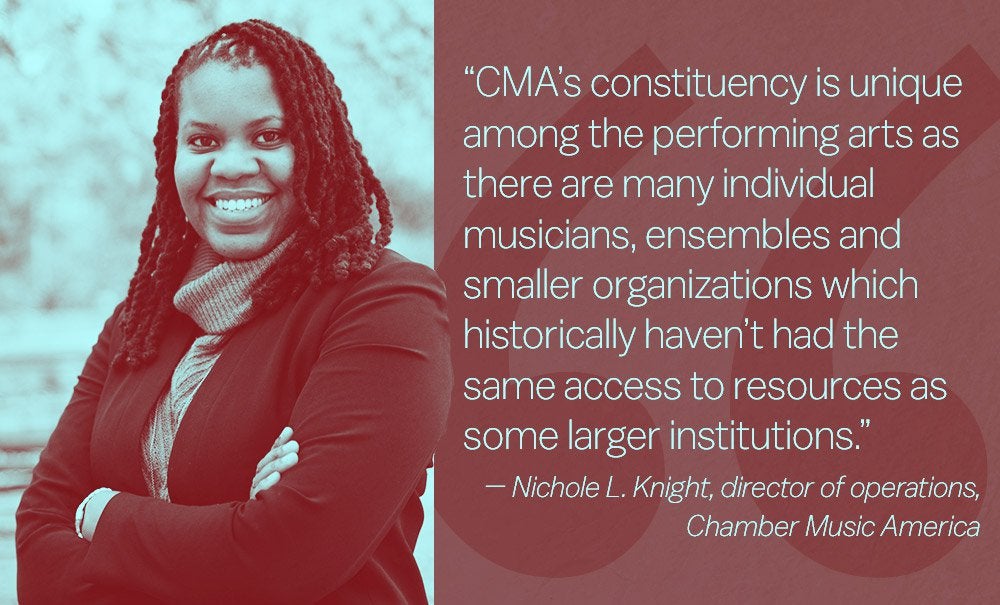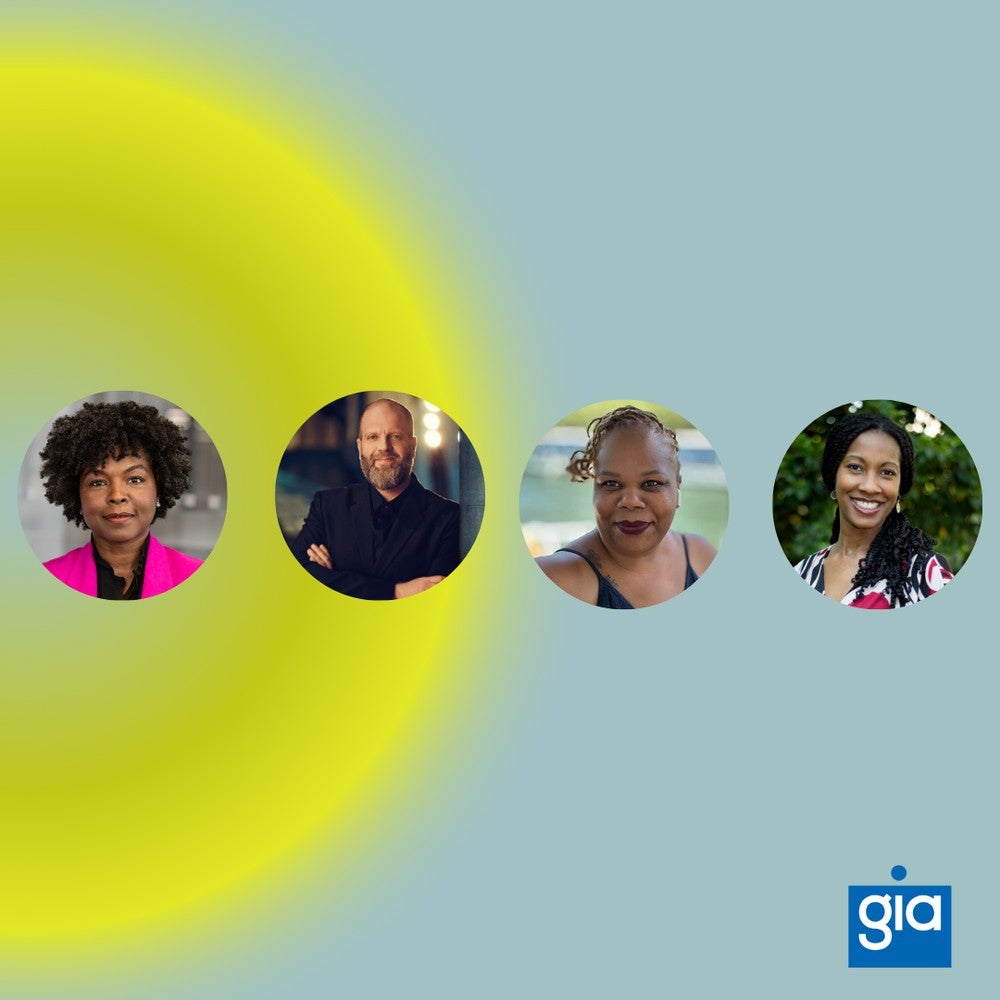The field of small ensemble music, despite its name, is mighty. It spans a range of genres—including classical, contemporary, jazz and more—performed by small groups of musicians (think: duet, trio, quartet, etc.) with one person per part, typically without a conductor. The musicians in these ensembles often function independently and generally work with fewer resources than those available to larger arts organizations. Still, these small groups have long persisted in the face of adversity, even during the Covid-19 pandemic. For example, The Westerlies, a New York-based brass quartet, figured out how to use technology to perform together, in sync, while quarantined in their homes. Similarly, the Hyde Park Jazz Festival, kept from its large outdoor stages and intimate indoor clubs on the South Side of Chicago, turned to livestreams and pop-up concerts in driveways, backyards and parks to bring music to Chicagoans where they live.
Chamber Music America (CMA), a national service organization that represents nearly 4,000 musicians, ensembles, presenting organizations, businesses and affiliates, conducted a series of Wallace-supported surveys to better understand the difficulties the field has faced and the ways in which they have worked to overcome them. The first survey, launched in April 2020, came as organizations were shutting down in response to Covid-19. Subsequent surveys in June 2020 and June 2021 show how small ensembles have adapted as the pandemic drags on.
We connected with Nichole L. Knight, CMA’s Director of Operations, over email to help understand what survey results reveal. A transcript of our conversation follows, with minor edits for readability.

The Wallace Foundation: What has been the biggest challenge overall that the small ensemble music field has faced throughout the Covid-19 pandemic?
Nichole Knight: CMA’s constituency is unique among the performing arts as there are many individual musicians, ensembles and smaller organizations which historically haven’t had the same access to resources as some larger institutions. During the pandemic, we saw that ensembles, in particular, weren’t eligible for the same recovery support that organizations and individuals were.
One survey respondent wrote, “For us, a small [nonprofit] who never formally laid ourselves off during this time, it meant that we were very limited in the number of artist-specific Covid relief programs we were eligible for.”
Our data confirm this. Our third survey suggested that over 60 percent of respondent organizations and individuals had received CARES Act funding, while less than 40 percent of respondent ensembles had obtained support.
But to take a step back, I want to reiterate what I hope we all understand by now: not everyone was affected by this pandemic equally. Some musicians could rely on teaching positions to supplement their income; others could not. Some presenting organizations had the infrastructure and the capacity to pivot to virtual programming, while others had to overcome learning and logistical barriers or could not afford the equipment necessary to do so. And when emergency funding became available to individuals, some members experienced additional barriers due to the lack of the digital tools/technology that were necessary to complete online applications. And [relief] funds were often depleted by the time they could access them.
We also know that those who have been traditionally marginalized—people of color and the economically disadvantaged—got sicker, experienced more loss of life within their families and communities, and will likely take longer to recover than their peers. And so all of the inequities we saw play out on a larger scale also happened within our field.
WF: What surprised you most about the survey results?
NK: I think the surveys told us what we expected to learn, which was that our constituents were having an extremely difficult time. But the results also helped paint a fuller picture of what they were going through and show that they weren’t alone.
That being said, our third survey, which closed mid-May but was published in June, showed that more than half of ensembles and organizations had already begun performing or presenting in-person performances. At that time, depending on the state, vaccines had just recently become available to most adults, and subsequent updates in prevention protocols were changing constantly. So I think that just proves how eager most people were to get out and perform, present and experience live music again, even without assurances of being 100 percent in the clear. [CMA did not ask about vaccination status in its 2021 survey.]
And while not surprising, per se, something that becomes very clear when looking at the survey results and thinking about the conversations CMA’s staff had with our members and constituents is how interconnected our discipline is. Certainly artists, presenters (and their venues) and audiences were affected by the shutdown. But that impact rippled exponentially to so many others. The livelihoods of artist managers, who have been unable to book work for their clients, and composers, who usually receive royalties when their work is performed, have also been drastically affected. So it’s going to take time for the entire field to recover.
WF: While respondents in June 2021 expressed that they're eager to return to live performances, the survey also found that many plan to continue using virtual programming in some capacity moving forward. What specific advantages does virtual or hybrid programming offer musicians and small ensembles? Does it present any particular challenges as well?
NK: I think the main benefit is the ability to engage new audiences regardless of their physical or geographic proximity. But there are barriers of cost and technological know-how in undertaking a new model. And even among the respondents who have adopted new technologies, the monetization of these virtual events has not made up for the revenue lost due to cancellations and postponements.
Another challenge musicians face is simply missing the energy of a live audience and the particular intimacy that comes with a small ensemble music performance. We’ve heard from our members time and again that while virtual programming may be great, nothing beats being in the room together.
WF: What are the biggest shifts within the field that you’ve noticed over the course of these three surveys from March 2020 to June 2021?
NK: The biggest tangible shift would be the increased use of technology. It was a common topic that members discussed in our virtual convenings, and we even hosted two webinars on it. In our most recent survey, respondents said they used approximately 25 different platforms, such as Zoom, social media platforms, Patreon and Twitch for their online activities (performances, rehearsals, webinars and workshops, private lessons, town halls, etc.).
In a larger sense, I would say there was a stark difference in attitudes toward the pandemic. Earlier on, respondents expressed more hopelessness. In the most recent survey, while still uncertain about the future, there seemed to be some more positivity and cautious optimism. (I’ll allow for the possibility that those who were feeling more positive were more willing to fill out the survey.) But the third survey was conducted before the current rise of the Delta variant and that is sure to have a strong impact on people and the field. So, it’s hard to be certain about attitudes right now.
WF: Based on what you’ve heard from your constituents through these surveys and otherwise, what do you think are going to be the biggest changes to the field as the pandemic subsides?
NK: I have a few thoughts on this. New ticketing models, for one. As I mentioned earlier, according to our surveys, overall, profits made from monetizing virtual events have not replaced in-person revenue. And vendors that maintain social distancing measures will continue to have limited capacity in their spaces. So I think we might see new ticketing models created to help make up for the extreme loss in revenue.
I think we will continue to see new tools and technologies or new ways of utilizing old ones to aid in recovery. For instance, I learned from our members about masks created to allow reed and wind players to rehearse and perform while masking up. So I think there is going to be a lot more innovation to accommodate a “new normal.”
Also, a lot of this innovation will come from the younger generation. Those who have been in school during this pandemic will have unique takeaways and bring new outlooks to their careers. A recent article in the Summer 2021 issue of Chamber Music highlights the silver linings educators and students have taken away from this past school year. They include everything from sharper listening and rehearsal skills, to adaptability, technological know-how and a renewed sense of commitment to and belief in the discipline.
And as the field continues to work toward dismantling racial inequity, everyone will have to develop strategies to address the fact that people of color have been and continue to be disproportionately affected by the pandemic. I’m not sure what that will look like exactly. But the old methods weren’t working even before the pandemic. So, organizations will have to adapt to thrive.
Photo of Nichole L. Knight by Kotaro Kashiwai




